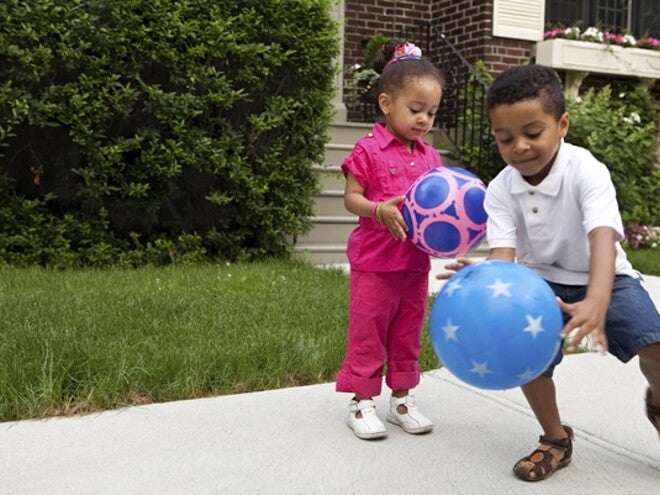
49 months Milestone
Your four-year-old can practice ball skills in many exciting ways.
Kicking: Show your child how to run towards a ball and kick it towards a target without stopping first. They can practice running and kicking a slow-moving ball. Your child will start getting good at kicking at about 4 ½ years of age.
Catching: Typical three-year-olds catch a tennis ball with their elbows bent in front of their bodies. In contrast, four-year-olds usually learn to keep their elbows nearer to their sides. They also now enjoy practicing to catch a larger ball that is bounced in their direction.
Throwing: Most four-year-olds are ready to learn how to “underhand” throw a tennis ball towards a target. They also enjoy learning how to throw it so that it hits the floor once before hitting the wall.
Having a ball
Ball play is very beneficial to a child’s development. There are two main reasons why we should play ball with our children from early on.
Firstly, ball play helps to develop important skills that impact a young child’s development in many practical ways.
Consider the following:
- Practicing to hit, catch, throw or kick a ball develops a sense of rhythm in your child. Interestingly, a well-developed sense of rhythm is necessary for smooth coordination as well as visualisation skills.
- Any kind of ball play also helps to develop body awareness. As children handle balls, they discover where their different body parts are, their functions, the space they need to carry out different actions and how much pressure these actions require. This develops the foundation for practical skills such as pressing down on a pencil with the correct amount of force.
- Learning to catch a large ball with two hands involves coordinating the left and right sides of the body. This is no easy feat as it involves the two-way communication of the brain, where the right half of the brain controls the left side of the body and vice versa. Without this skill – known as bilateral integration – children struggle to do practical tasks such as dressing themselves and cutting with scissors.
- Whenever children practice throwing a ball, they develop an internal sense of timing and direction. Practicing to throw a ball strengthens a child’s neural network in their brain. Each throw improves the communication between the brain, muscles and ligaments that work together to perform this action. These messages coordinate the movement of your child’s arms and hands to aim in the intended direction and release the ball at exactly the right time. Neural networks learn from experience.
Secondly, learning to control a ball is a necessary part of developing “movement literacy”.
Nobody needs to teach a typical child how to walk, bend over to pick something up, or climb a flight of stairs. Why? Because these skills are necessary for survival and acquiring them is built into the human DNA.
On the other hand, many of the task-specific skills that your child is going to need to play sports are learnt.
Skills such as jumping over hurdles, handling balls and somersaulting are learnt. They do not happen automatically. The only way to master them is to be taught, followed by lots of practice until the technique becomes second nature.
The good news is that we can prepare our children for success in any kind of sport by teaching them a set of fundamental movement skills.
These skills are recognised worldwide as the building blocks of movement and the “alphabet of movement literacy.” They include locomotor and non-locomotor (stabilisation) skills. Encourage your child to roll, balance, slide, jog, run, leap, jump, hop, dodge, gallop and skip.
Ball skills teach object control and can be learnt by bouncing, throwing, catching, kicking and striking balls.
There you go! Now, where’s that ball?
Tip: Alternatives to balls
If your child does not yet enjoy playing with balls, bear in mind that smaller and heavier balls are more difficult to catch as they require better timing and faster tracking skills.
So, to provide more opportunities for success, put the soccer and tennis balls aside for a while and play catch with balloons, beach balls, foam balls or bean bags instead.
Also, demonstrate how to throw a tennis ball like a cricket bowler (with an overarm action). Show your child how to grip the ball firmly in the dominant hand, touch it to their ear. Next, they must step forward with the foot opposite to the throwing hand while straightening their arm to cast it forward.